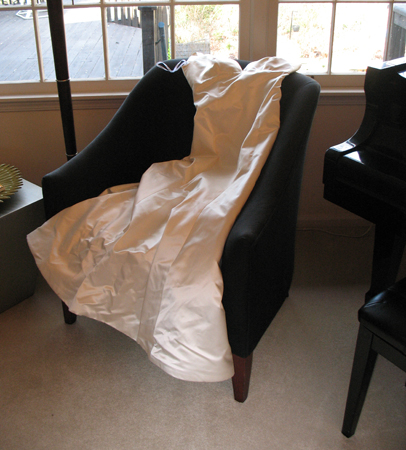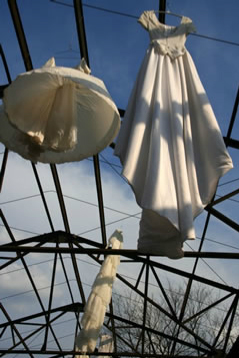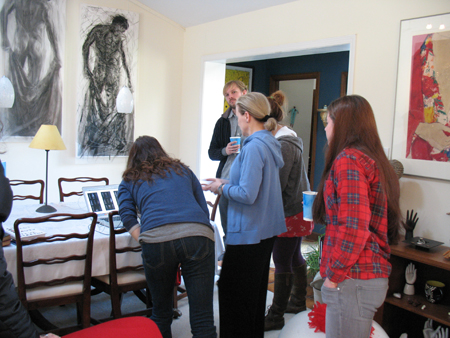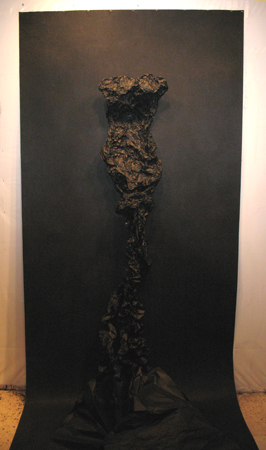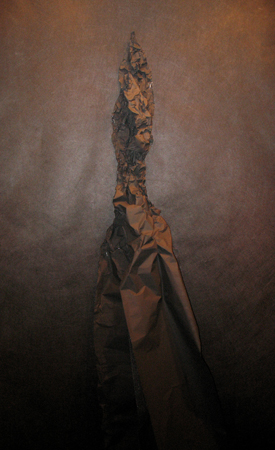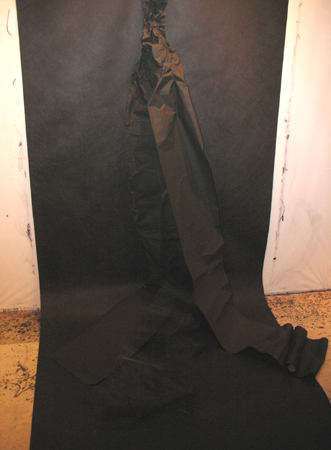Two weekends ago, Seek ATL held a studio visit with the Atlanta artist Elyse Defoor. Her studio is on the lower level, underneath a labyrinth of rooms in her Chamblee home. Elyse has been on the Atlanta art scene for some time, and has developed several bodies of work that deal with societal relationships and marriage. The artist admitted to having been married four times and suggested that those partnerships have played into her work.
Elyse showed us her recent work, along with beautiful photography (her own) and a video that artist Ande Cook had created, of Defoor’s installation this past fall at the Atlanta Arts Exchange. Titled ‘Relics of Marriage’, the work consisted of about thirty used wedding dresses – one unused – all hung from exterior scaffolding. The dresses withstood rain, wind and falls during the exhibit, to the pavement below. The analogy to the rigors of marriage is obvious, the beauty of the installation surprising.
Her own wedding dress, used in the piece, was draped across a chair in her living room, next to the piano. Defoor states on her site: “These public experiences are invitations to dialogue on the changing concept of marriage today.”
Upstairs, large manipulated photographs on mylar hung in the dining room. These are from Defoor’s 2010 exhibit “Via Dorso”, shown at the Wm Turner Gallery .
The artist’s newest pieces still depict a kind of figurative female form and dress, but it is more difficult to pinpoint her motivation. What appears to be black crumpled iridescent paper pinned with a single thumb tack to backdrops of black paper rolls, netting attached at the base of one roll, these two sculptural forms are reminiscent of Rauschenberg’s black paintings. Texture is difficult to see in a photograph, but is discernible in the light of her studio space.
Abstracted and mysterious, these two pieces could be seen as a response to the institution of marriage, especially in light of Defoor’s prior series. A more facile interpretation is that they reflect the inevitable crumbling of relationships. There was mention of decay as a descriptor, during the studio visit.
However, I would suggest that these are the artist’s attempt to go beyond the tradition of harping on male/female tension and the tedium that results. Defoor has said that she was interested in a spiritual connection during her Via Dorso series. In this new work, a more internalized emotionalism widens her role as an artist. In Rauschenberg’s early black series from the 1950’s, he experiments with the formal aspect of painting to reduce its qualities to pure experience.
Like Rauschenberg, Defoor’s new work may be intellectual experimentation with an idea that doesn’t necessarily dictate destruction or any other emotional extreme. If her paper had been white, that color and its symbolism could have just as easily played into the viewer’s reaction. His response to critics who found similar associations to his black paintings in an interview now transcribed in the Archive of American Art; “there had been a lot of critics who shared the idea with a lot of the public that they couldn’t see black as color or as pigment, but they immediately moved into associations and the associations were always of destroyed newspapers, of burned newspapers. And that began to bother me. Because I think that I’m never sure of what the impulse is psychologically. I don’t mess around with my subconscious. I mean I try to keep wide awake. And if I see in the superficial subconscious relationships that I’m familiar with, cliches of association, I change the picture. I always have a good reason for taking something out but I never have one for putting something in. And I don’t want to, because that means that the picture is being painted predigested.”
Defoors’ strength as an artist is that she continually changes the picture and expands her vision.

